If you’re looking to improve your website’s search engine ranking, understanding how to use anchor text in SEO is crucial. When creating links, it is important to use anchor text that accurately reflects the content of the target page and is relevant to the keywords you are targeting. This helps search engines understand the context of the link and the relevance of the target page to the linked page.
In this comprehensive guide, we will explore the different aspects of anchor text and provide actionable tips you can use to create an effective anchor text strategy.
Understanding how to use anchor text in SEO
Anchor text is the clickable text that appears as a hyperlink on a website. It signals to search engines about the content of the linked page and its relevance to the target page. In SEO, anchor text is important because it helps to build authority and trust, and also contributes to the overall link profile of a website.
Let’s say you have a website about sports and you want to create a link to an article about the best basketball shoes. You can use anchor text to describe the content of the article and help search engines understand what the linked page is about.

In this code, the anchor text is “Check out our article on the best basketball shoes”. When a search engine crawls this page, it will understand that the linked page is about the best basketball shoes because of the relevant anchor text.
It’s important to use descriptive anchor text that accurately reflects the content of the linked page. Avoid using generic anchor text like “click here” or “read more”, as these don’t provide any useful information to search engines.
Types of anchor text
There are different types of anchor text that can be used in SEO. Some of the most common types include:
- Exact match
This anchor text uses the exact keyword or phrase that you are targeting as the hyperlink. This type of anchor text is considered the most powerful in terms of SEO.
Example: <a href=”https://example.com/dog-food“>dog food</a>

- Partial match
Such anchor text uses a variation of the keyword or phrase that you are targeting as the hyperlink.If you target the keyword “dog food,” a partial match anchor text could be “best dog food brands.”
Example:<a href=”https://example.com/ “>best dog food brands</a>

- Branded
It uses the name of the brand or website as the hyperlink. This type of anchor text is commonly used when linking to the homepage of a website.
Example: <a href=”https://example.com“>Merrick</a>

- Generic
Such anchor text uses generic phrases such as “click here,” “read more,” or “visit this page” as hyperlinks. This type of anchor text is not as powerful as exact or partial match anchor text, but it can help to diversify the link profile of a website.
Example: <a href=”https://example.com/contact-us“>Contact Us</a>

- Naked URL
This anchor text uses the URL of the target page as the hyperlink. This type of anchor text is not as powerful as other types of anchor text, but it can be useful in certain situations.
Example: <a href=”https://example.com/dog-food“>https://example.com/dog-food</a>

- LSI keywords
LSI (Latent Semantic Indexing) keywords are related keywords that are semantically related to the main keyword or phrase. Using LSI keywords as anchor text can help to improve the relevancy of the link and provide additional context to search engines.
Example: <a href=”https://example.com/dog-food“>healthy dog food options</a>

- Image anchors
Such anchors use an image as the hyperlink instead of text. Image anchors can be used in conjunction with alt text to provide additional context to search engines.
Example: <a href=”https://example.com“><img src=”image.jpg” alt=”Example Image”></a>

How to build an anchor text list
Building an effective anchor text list is essential for SEO success. Here’s a step-by-step guide that outlines the process of building an anchor text list:
Step 1: Use Ahrefs to identify your top competitors in your niche and analyze their anchor text profiles. Look for anchor text types and keywords that are working well in your industry.
For example, let’s look at organic competitors of apple.com:
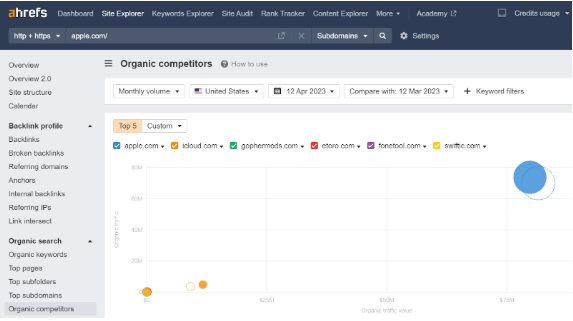
Here are the top competing domains:
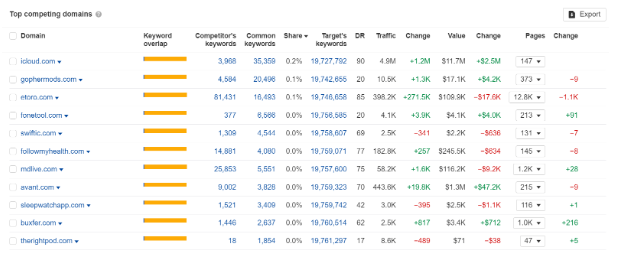
Now, you can take a look at the anchor text profile of Apple’s top competitor, icloud.com, and find anchor text types and keywords that work well.
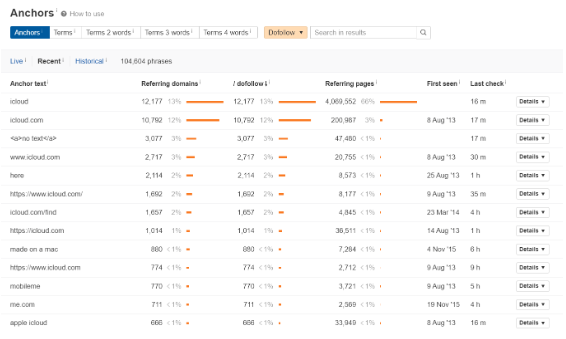
Step 2: Use Ahrefs, Chat GPT, or other keyword research tools to identify high-traffic, low-competition keywords that are relevant to your niche or industry.
You can ask Chat GPT to provide you with keywords, and then check them in Ahrefs.
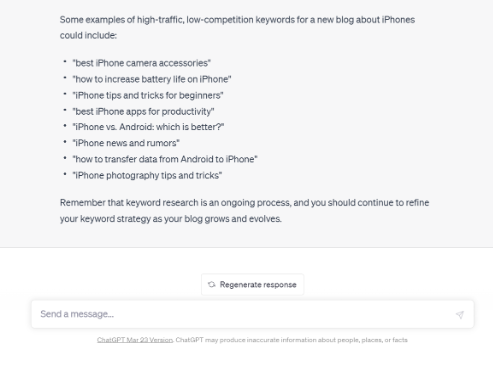
So, Chat GPT gave us a list of keywords, let’s check one of them in Ahrefs:
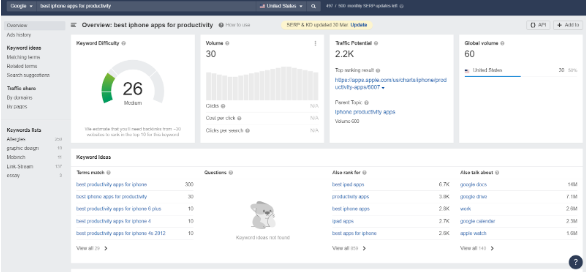
So, keyword “best iPhone apps for productivity” presents a moderate level of difficulty and has a potential traffic volume of 2.2K.
Step 3: Use Ahrefs to create a list of keywords you want to target with your anchor text strategy.
Here’s how you can identify high-traffic, low-competition keywords using Ahrefs:
- Log in to your Ahrefs account and select the “Keyword Explorer” tool.
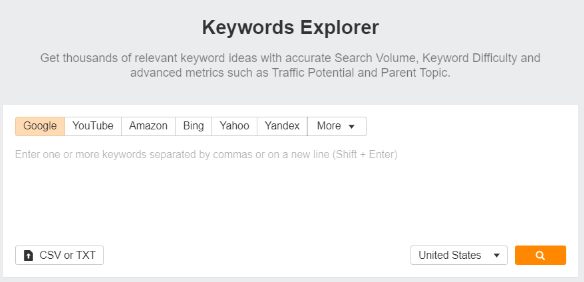
2. Enter a seed keyword related to your niche in the search bar. For example, “iPhone apps.”

3. Scroll down to the “Keyword ideas” section and apply filters to sort the keywords by search volume and keyword difficulty. You can set the search volume filter to a minimum of 1K or 2K depending on your preference. For keyword difficulty, you can set the filter to a maximum of 30 to find low-competition keywords.
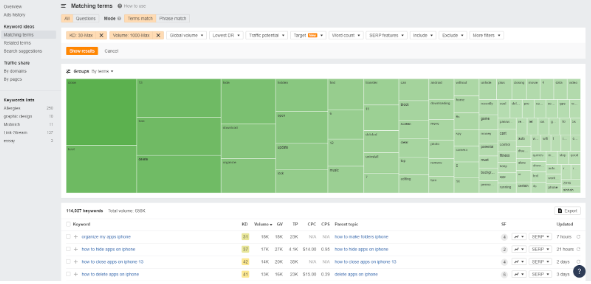
4. Review the list of keywords that meet your search volume and keyword difficulty criteria. Look for long-tail keywords, as these tend to have lower competition and higher relevance to your niche.
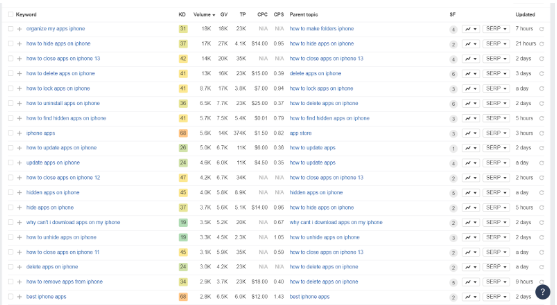
5. Use Ahrefs or MozBar to analyze the SERP (search engine results page) for each keyword to determine if it is a good fit for your blog. Look for the types of content that appear on the first page of Google and assess whether your blog post could compete with those pages.
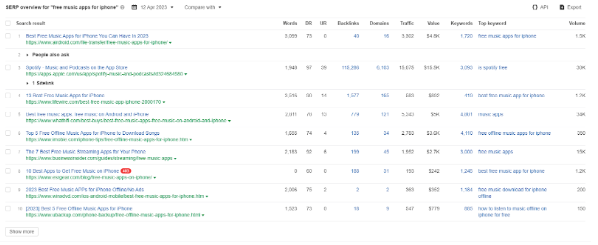
Step 4: Categorize your keywords based on their search volume and competitiveness.

You can cluster keywords using Surfer SEO’s keyword research tool:
- Sign in to your Surfer SEO account and go to the Keyword Research section.
- Enter the keyword you want to analyze in the search bar and click the search button.
- In the left sidebar, select the “Clustering” option.
- Surfer SEO will generate a list of related keywords and group them into clusters based on their semantic similarity.
- Each cluster will have a primary keyword and a list of related keywords that you can use to optimize your content.
- Click on a cluster to view its details, including the search volume, keyword difficulty, and other important metrics.
- Use the data to create a content strategy that focuses on the most relevant and high-potential keywords in each cluster.
- You can also export the data to a CSV file for further analysis and organization.
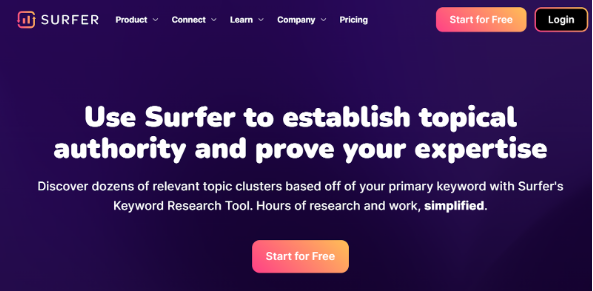
Step 5: Determine which anchor text types you want to use in your strategy. This may include exact match, partial match, branded, generic, or a combination of these types.
Step 6: Create a balanced distribution: Create a balanced distribution of anchor text types and keywords. Avoid over-optimization by using natural language and varying anchor text types and keywords.
Best practices for optimizing anchor text
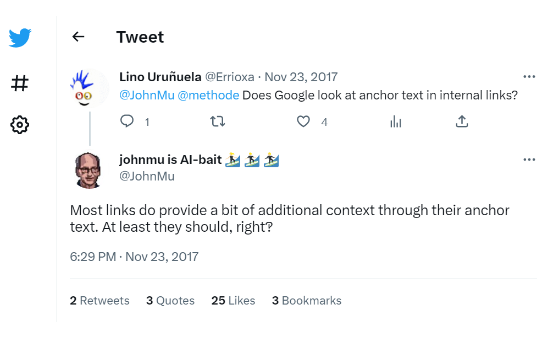
According to Google’s John Mueller, Google uses anchor text to help understand the context of the link.
By optimizing anchor text, you can improve your website’s search rankings, user experience, and overall site visibility. Here are some best practices for optimizing anchor text:
- Diversifying your anchor text profile
A diverse anchor text profile helps to improve your site’s search rankings and avoid penalties from search engines. It is essential to use different types of anchor text, for example:
Exact match: This anchor text uses the exact keyword or phrase you want to rank for (e.g., “best smartphones”).
Partial match: This type of anchor text uses a variation of your target keyword (e.g., “top smartphones of 2025”).
Generic: Generic anchor text uses common phrases, like “click here” or “learn more.”
A study by Ahrefs found that websites with a diverse anchor text profile tend to rank higher in search results.
- Matching anchor text with target page content
Using anchor text that accurately reflects the content of the target page helps users and search engines understand the context of the link.
For example, if your target page is about “vegetarian recipes,” use anchor text like “delicious vegetarian recipes” instead of unrelated phrases.
According to a Moz study, well-matched anchor text can improve a page’s search rankings and user experience.
- Avoiding over-optimization
Over-optimization of anchor text can lead to penalties from search engines. It is important to use natural language and a diverse range of anchor text types and keywords.
In 2012, Google launched the Penguin algorithm update to penalize sites using manipulative link-building practices. To avoid penalties, it’s crucial to avoid keyword stuffing and over-optimization.
- Using natural language and variations
Anchor text should read naturally and be relevant to the content. Incorporate long-tail keywords, synonyms, and related phrases to diversify your anchor text and create a more natural link profile.
For example, instead of using “best smartphones” repeatedly, try variations like “top mobile phones,” “leading smartphones,” or “high-quality cell phones.”
- Monitoring and adjusting anchor text strategy
Regularly analyze your site’s anchor text profile and make adjustments to optimize your SEO efforts. Tools like Moz’s Link Explorer or Ahrefs’ Site Explorer can help you monitor your anchor text distribution and identify areas for improvement.
Continuously refining your anchor text strategy ensures that your SEO efforts remain effective and up-to-date with search engine best practices.
Anchor text hacks: how to get fast SEO results
Anchor text optimization can be an effective SEO strategy, but it is important to use it correctly and in moderation to avoid penalties from search engines. Here are some anchor text hacks to get fast SEO results:
- Capitalizing on long-tail keywords
Capitalizing on long-tail keywords can help to improve the relevance of the link.
- Utilizing internal linking
It can help to improve the overall link profile of a website and provide additional context to search engines.
- Leveraging guest posting and content collaboration
Leveraging guest posting and content collaboration can help to build high-quality backlinks.
- Earning editorial backlinks through high-quality content
Backlinks from high-quality content can help to improve the overall link profile of a website.
If you have any questions about anchor text, we’d be happy to answer them during a free consultation.
